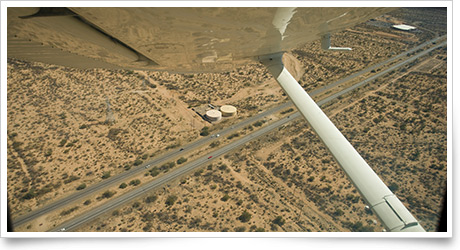training tipsConcept: Constant-radius turn
As many diagrams illustrate, S-turns across a road (or some other reference line like a long, straight set of railroad tracks) require the pilot to steepen and shallow the bank angle in response to changing groundspeed to maintain that distance. Begin the maneuver above and perpendicular to your reference line, headed downwind, where the steepest bank angle must be used. Varying the bank angle (and the turn rate) as the turn to the upwind heading progresses, strive to reach the wings-level point, after 180 degrees of turn, directly above your reference line. Then immediately commence a turn in the opposite direction.
As with the other ground-reference maneuvers, this one is flown at an altitude between 600 feet and 1,000 feet above ground level—why?
These are several of the reasons outlined in Chapter 6 of the Airplane Flying Handbook: Aircraft speed and type are considerations. Relative to the ground, your speed should not be "so apparent that events happen too rapidly." Objects on the ground should appear "in their proportion and size." Wind drift should be easy to discern, “but not tax the student too much in making corrections."
As that multitude of factors shows, it is important for you to practice until you can divide attention "between airplane control and the ground track while maintaining coordinated flight" as mandated in the Private Pilot Practical Test Standards.
Another test standard—crucial at the fairly low altitudes used for ground-reference maneuvers—is staying alert for forced-landing sites.
Be a good neighbor by flying your maneuvers away from "communities, livestock, or groups of people."
Maneuvers are placed in a training course to impart specific skills and concepts such as the constant-radius turn. But they also introduce etiquette, and respect for those on the ground, at training's early stages. training productsASA offers sport pilot testASA is offering preparation and study software for the sport pilot FAA knowledge exam. The software allows users to take true-to-form practice exams and get immediate feedback on the test areas that need more work. Tailor-made practice sessions improve your performance in the areas you need to concentrate on the most to pass the test. The cost is $27.85. WINGsReality EDU offers online courseWINGsReality EDU has released its Flight Review Ground School. The online program helps students learn more about aeronautical decision making, runway incursion avoidance, accident causal factors, and many other topics that are critical to flight safety. The course costs $29.95, which includes a logbook endorsement.
Note: Products listed have not been evaluated by ePilot editors unless otherwise noted. AOPA assumes no responsibility for products or services listed or for claims or actions by manufacturers or vendors. final examQuestion: Why are vice presidential temporary flight restrictions (TFRs) published with above ground level (agl) altitudes when presidential TFRs are published with mean sea level (msl) altitudes?
Answer: Vice presidential TFR altitudes normally only extend to 3,000 feet agl. If the TFR were 3,000 feet msl, the top of the TFR would be underground in many places such as Denver. So the Secret Service requests the FAA use altitudes above ground level to make sure it has the buffer it needs. Since presidential TFRs are normally 18,000 feet, a mean sea level altitude works fine. Here's a link to the FAA's current TFR map.
Got a question for our technical services staff? Email [email protected] or call the Pilot Information Center, 800/872-2672. Don’t forget the online archive of “Final Exam” questions and answers, searchable by keyword or topic. |
 A student pilot learns to master three ground-reference maneuvers in preparation for the private pilot flight test. The rectangular course allows your examiner to assess your skill in flying a course equidistant from all sides of a rectangular ground area. This requires you to establish headings that counter the drift effect of wind (including when rolling out of turns). The other two required ground-reference maneuvers,
A student pilot learns to master three ground-reference maneuvers in preparation for the private pilot flight test. The rectangular course allows your examiner to assess your skill in flying a course equidistant from all sides of a rectangular ground area. This requires you to establish headings that counter the drift effect of wind (including when rolling out of turns). The other two required ground-reference maneuvers, 

